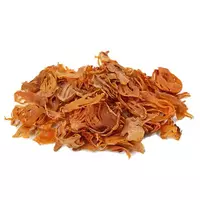Nutmeg matsis

The nutmeg color of matsis is a spice that is a specially dried adherent of Nutmeg fragrans (Myristica fragrans). This plant is better known in the people called nutmeg. Another name for Myristica nutmeg from the Latin name Myristica is also common. Currently, science knows about 120 species of nutmeg. Researchers believe that the birthplace of nutmeg is the Moluccas, whose territory is located between New Guinea and Sulawesi.
It is worth noting that the Moluccas are often called nothing more than Spice Islands, this is also due to the spread of nutmeg in these territories. In addition, the region is famous for clove tree plantations. The population of the Moluccas lives on agriculture and supplies to the world spice markets, as well as cocoa and exotic tropical fruits. Spicy nutmeg color or matsis is not obtained from nutmeg inflorescence. Matsis is nothing more than the surrounding seed of a juicy, bright red natural film.
In biology, this part of the seed is called arillus. The technology of spicy production of nutmeg matsis deserves special attention. Moreover, the quality of the finished spice depends on compliance with all important stages of the production process. In order to make a nutmeg color, the macis arillus or pericarp is carefully separated from the seed. Moreover, it is necessary to do this so as not to damage delicate natural material. It is worth noting that whole dried nutmeg arillus is valued much higher than the so-called broken matsis.
After the fragile arillus is separated from the nutmeg seed, the plant material is dried naturally in the sun. After some time, the matsis is laid out on mats and kept until the plant material becomes soft. The nutmeg is then flattened and dried again. When dried, the nutmeg color can be either a dark yellow or a light orange hue.
As a rule, nutmeg or matsis crushed to a powdered state is supplied to the European market. As a spice, nutmeg color has a pleasant aroma and is distinguished by a burning taste with spicy notes. It is worth emphasizing especially that the taste, aroma and consumer properties of nutmeg and nutmeg have nothing to do. Nutmeg and nut are completely two different spices that have found a fairly wide application in cooking. Nutmeg color is used in the confectionery industry, as well as in baking.
Usually the spice is included in desserts and pastries. However, matsis gives a distinctive taste and bright aroma not only to confectionery, but also to soups, as well as sauces. The spice perfectly emphasizes the taste of beef dishes, in addition, matsis is perfectly combined with cheeses and sausages. Interestingly, this spice has entered the culinary tradition of both Asian and European states.
The English and French consider nutmeg a mandatory seasoning, as do countries that were colonies of great powers. For example, in India, the nutmeg color of matsis is part of the famous garam masala or curry seasoning mixtures. Matsis is used not only as a spice, but also a material for producing vegetable oil, which is used in the food and cosmetic industries.
nutmeg-colored matsis 475 kCal
Energy value of nutmeg-colored matsis (Ratio of proteins, fats, carbohydrates - ju):
Proteins: 6.71 g (~ 27 kCal)
Fats: 32.38 g. (~ 291 kCal)
Carbohydrates: 30.3 g (~ 121 kCal)
Energy ratio (bj | y): 6% | 61% | 26%
 Español
Español Français
Français Português
Português Русский
Русский 简体中文
简体中文 繁體中文
繁體中文 日本語
日本語 한국어
한국어 العربية
العربية Türkçe
Türkçe Қазақ
Қазақ Deutsch
Deutsch Italiano
Italiano Українська
Українська
